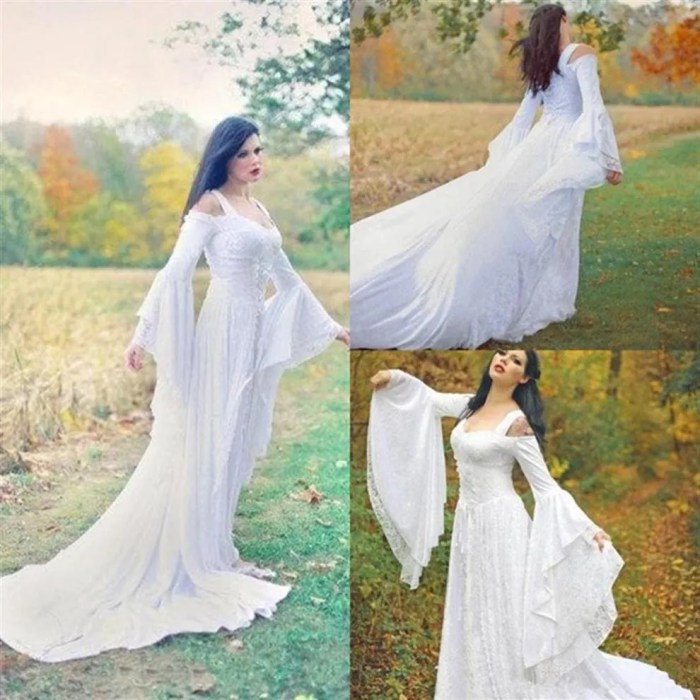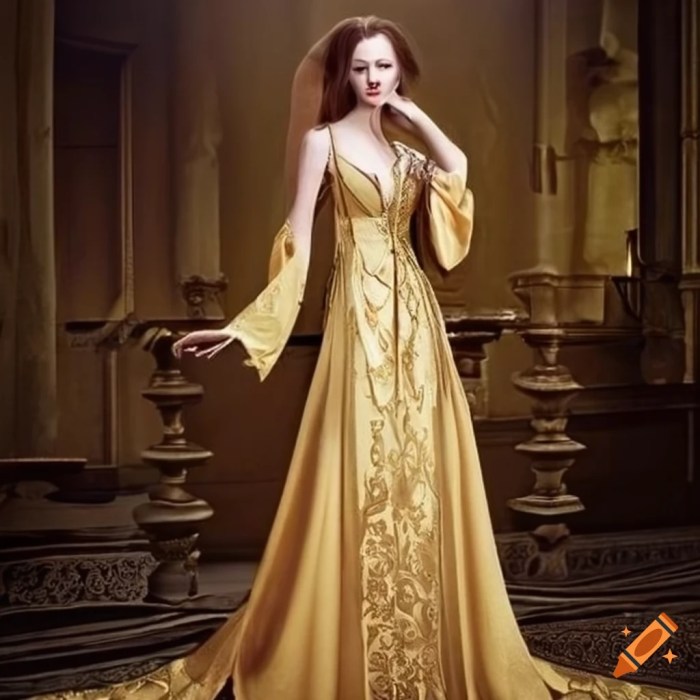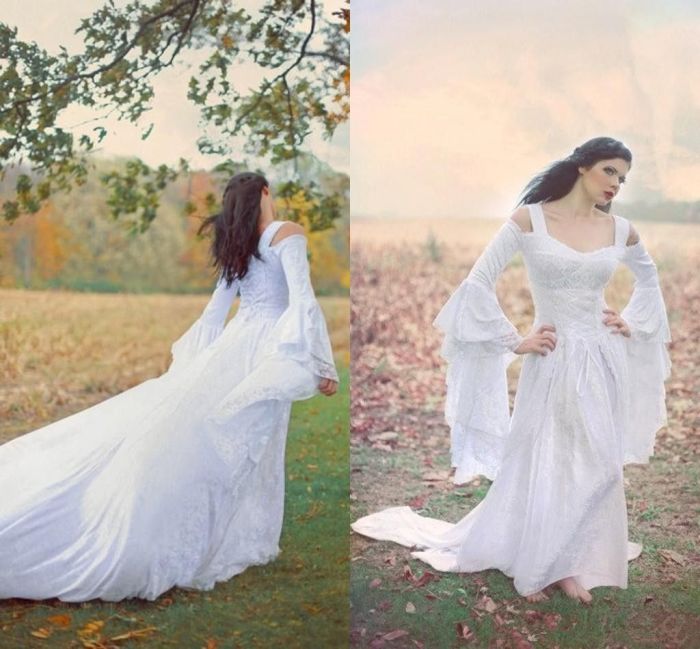Defining the “Fairy Medieval Wedding Dress” Aesthetic

Source: dhresource.com
The “fairy medieval wedding dress” aesthetic blends the ethereal charm of fantasy with the historical richness of medieval attire. It’s a style that draws inspiration from various sources, resulting in a unique and captivating look.
Key Visual Elements of a Fairy Medieval Wedding Dress
Key visual elements typically include flowing fabrics, intricate embellishments, and a romantic silhouette. Think flowing gowns with long sleeves, perhaps a slightly fitted bodice, and a full skirt. Details like delicate lace, embroidery, and subtle beading add to the overall magical feel. The overall impression is one of ethereal beauty and timeless elegance.
Historical Influences and Modern Interpretations

Source: craiyon.com
The style borrows from medieval garments, particularly those of the later periods (14th-15th centuries), incorporating elements like long, flowing sleeves, high necklines, and possibly even a pointed or surplice bodice. However, the “fairy” aspect introduces a lighter, more romantic touch, often using softer fabrics and more delicate embellishments than strictly historical counterparts. Modern interpretations prioritize comfort and movement, often incorporating elements like more comfortable undergarments and less restrictive silhouettes compared to their historical counterparts.
Distinguishing “Fairy” and “Medieval” Aesthetics
A purely “medieval” wedding dress might adhere more strictly to historical accuracy, using heavier fabrics, more structured silhouettes, and potentially less ornamentation. A “fairy” aesthetic, however, prioritizes a whimsical and romantic feel, often incorporating lighter colors, flowing fabrics, and delicate details. The combination seeks to capture the romantic essence of medieval aesthetics while adding a touch of fantasy.
Comparison of Fairy Medieval Wedding Dress Interpretations
| Style | Fabric | Details | Overall Impression |
|---|---|---|---|
| Romantic Bohemian | Silk chiffon, lace | Floral embroidery, delicate beading, flowing sleeves | Light, airy, and whimsical |
| Elegant Medieval | Heavy silk brocade, velvet | Intricate embroidery, jeweled accents, fitted bodice | Rich, luxurious, and regal |
| Whimsical Woodland | Linen, cotton, tulle | Flower appliqués, delicate vines, flowing skirt | Natural, ethereal, and enchanting |
| Gothic Romantic | Velvet, lace, silk | Darker color palette, intricate embroidery, long sleeves | Mysterious, romantic, and dramatic |
| Classic Fairy Tale | Silk organza, satin | Lace overlay, delicate beading, long train | Timeless, elegant, and fairytale-like |
Fabric and Construction Techniques
The choice of fabrics and construction techniques significantly impacts the final look and feel of a fairy medieval wedding dress. A variety of materials and techniques can be employed to create the desired aesthetic.
Fabric Choices
Common fabrics include silk (various weights and types), linen (for a more rustic feel), lace (for delicate details), cotton (for lining or underlayers), and tulle (for added volume and texture). The choice of fabric dictates the drape, texture, and overall impression of the gown.
Construction Techniques
Construction techniques often involve intricate hand-stitching, embroidery (using various threads and techniques), beading (with glass beads, pearls, or gemstones), and appliqué (applying decorative fabric pieces). These techniques add depth, texture, and visual interest to the dress.
Fabric Influence on Overall Look
Heavier fabrics like velvet or brocade create a more opulent and regal look, while lighter fabrics like chiffon or silk organza create a more ethereal and flowing silhouette. The interplay of textures, achieved through combining different fabrics, adds another layer of visual richness.
Step-by-Step Sleeve Construction
To create a typical long, flowing sleeve, one might start by drafting a sleeve pattern based on the arm circumference and desired length. The pattern is then cut from the chosen fabric, allowing for seam allowances. The sleeve pieces are sewn together at the seams, and then the sleeve is gathered or pleated at the shoulder to create the desired fullness.
Finally, any embellishments like lace or embroidery are added.
Color Palettes and Design Elements
Color palettes play a significant role in shaping the mood and atmosphere of a fairy medieval wedding dress. The symbolic meaning of colors adds another layer of depth and meaning to the design.
Common Color Palettes
Common color palettes include ivory and cream for a classic look, pastel shades (such as lavender, blush pink, and mint green) for a romantic feel, deeper jewel tones (emerald green, sapphire blue, ruby red) for a more regal or mysterious vibe, and earthy tones (browns, greens, and creams) for a woodland or bohemian aesthetic.
Symbolic Meaning of Colors
Ivory and cream symbolize purity and innocence. Pastels represent romance and gentleness. Jewel tones signify richness and sophistication. Earthy tones evoke a connection to nature.
Color Combinations and Moods
A combination of ivory and blush pink creates a delicate and romantic feel, while emerald green and deep burgundy create a more dramatic and luxurious atmosphere. The interplay of light and dark shades can add depth and visual interest to the design.
Mood Board Examples
- Palette 1: Romantic Pastel: Blush pink, lavender, ivory. Effect: Sweet, delicate, and dreamy.
- Palette 2: Regal Jewel Tones: Emerald green, sapphire blue, gold. Effect: Rich, luxurious, and sophisticated.
- Palette 3: Earthy Woodland: Deep greens, browns, creams. Effect: Natural, earthy, and mystical.
- Palette 4: Gothic Romance: Deep burgundy, black, silver. Effect: Dramatic, mysterious, and alluring.
Accessories and Styling
Accessories and styling choices are crucial in completing the fairy medieval wedding dress look. They contribute significantly to the overall aesthetic and enhance the overall impression.
Complementary Accessories
Accessories such as floral crowns or jeweled headpieces, delicate necklaces and earrings, and elegant footwear (perhaps laced boots or embroidered slippers) add to the overall romantic and whimsical feel. A long train can also add to the drama and elegance of the dress.
Accessories’ Contribution to Aesthetic
A floral crown adds a touch of nature and whimsy, while a jeweled headpiece adds a touch of regal elegance. Delicate jewelry complements the dress without overwhelming it. Footwear should be chosen to complement the style and silhouette of the dress.
Styling Choices: Hair, Makeup, and Presentation
Hair can be styled in loose waves or braids, adorned with flowers or ribbons. Makeup should be natural and enhancing, emphasizing the eyes and lips. The overall presentation should be romantic, ethereal, and sophisticated.
Accessory Ideas
- Headwear: Floral crowns, jeweled headbands, veils with lace detailing.
- Jewelry: Delicate necklaces, pearl earrings, jeweled brooches.
- Footwear: Embroidered slippers, laced boots, elegant sandals.
- Other: Embroidered gloves, a long train, a delicate shawl or cape.
Illustrative Examples
Three distinct fairy medieval wedding dresses illustrate the versatility of this style. Each design showcases different fabric choices, color palettes, and design elements, resulting in unique and captivating looks.
Example 1: The Enchanted Forest Dress
This dress features a flowing skirt made of ivory silk organza, layered with delicate lace. The bodice is fitted, with a sweetheart neckline and intricate floral embroidery in shades of green and cream. Accessories include a floral crown made of wildflowers and delicate silver jewelry. The overall impression is one of ethereal beauty and natural charm.
Example 2: The Regal Court Dress
This dress is made of deep emerald green velvet, with a fitted bodice and a full skirt. The sleeves are long and flowing, adorned with intricate gold embroidery. The accessories include a jeweled headpiece, a long velvet train, and elegant gold earrings. The overall impression is one of regal elegance and sophistication.
Example 3: The Whimsical Woodland Dress, Fairy medieval wedding dress

Source: dhresource.com
This dress is made of blush pink linen, with a loose-fitting bodice and a full, flowing skirt. The sleeves are long and gathered, with delicate flower appliqués scattered throughout. Accessories include a simple floral crown, delicate pearl earrings, and rustic-style sandals. The overall impression is one of lighthearted charm and whimsical beauty.
Question & Answer Hub
What is the typical price range for a fairy medieval wedding dress?
The ethereal beauty of a fairy medieval wedding dress often features intricate detailing and flowing fabrics. Finding the perfect fit, however, is crucial, and for those with curvier figures, selecting a design that flatters is paramount. To discover gowns that celebrate your shape, consider exploring resources like this guide on best wedding dresses for curvy figures before settling on your final fairy tale design.
This ensures your fairy medieval wedding dress not only looks magical but also feels incredibly comfortable and confident.
The cost varies greatly depending on the designer, fabric choices, and level of detail. Expect a wide range, from several hundred to several thousand dollars.
Where can I find a fairy medieval wedding dress?
You can find custom-made dresses from independent designers, explore vintage or antique shops, or adapt existing gowns with alterations. Online marketplaces may also offer options.
How do I care for a fairy medieval wedding dress after the wedding?
Professional cleaning and preservation are recommended to maintain the dress’s condition. Follow the care instructions provided by the designer or cleaner.
Can I incorporate modern elements into a fairy medieval wedding dress?
Absolutely! Blending modern silhouettes, fabrics, or embellishments can create a unique and personalized look while maintaining the overall aesthetic.
